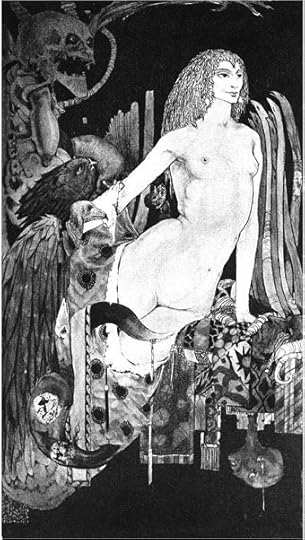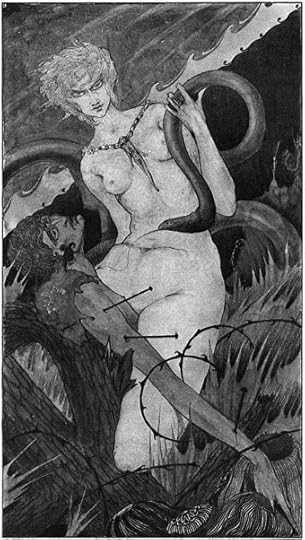John Coulthart's Blog, page 301
August 13, 2011
Weekend links
Manuel Orazi (1860–1934) was one of the best of the many Mucha imitators. An untitled & undated posting at Indigo Asmodel.
The mob now appeared to consider themselves as superior to all authority; they declared their resolution to burn all the remaining public prisons, and demolish the Bank, the Temple, Gray's Inn, Lincoln's Inn, the Mansion House, the Royal palaces, and the arsenal at Woolwich. The attempt upon the Bank of England was actually made twice in the course of one day; but both attacks were but feebly conducted and the rioters easily repulsed, several of them falling by the fire of the military, and many others being severely wounded.
To form an adequate idea of the distress of the inhabitants in every part of the City would be impossible. Six-and-thirty fires were to be seen blazing in the metropolis during the night.
An Account of the Riots in London in 1780, from The Newgate Calendar.
In a week of apparently limitless bloviation, a few comments stood out. Hari Kunzru: "Once, a powerful woman told us there was no such thing as society and set about engineering our country to fit her theory. Well, she got her way. This is where we live now, and if we don't like it, we ought to make a change." Howard Jacobson: "One medium-sized banker's bonus would probably pay for all the trash that's been looted this past week." Meanwhile Boff Whalley complained about the predictable misuse of the word "anarchy" by lazy journalists.
• For further historical perspective, a list of rioters and arsonists from The Newgate Calendar (1824), and an account of the looting in London during the Blitz.

From a selection of works by Max Walter Svanberg (1912–1994) at But Does It Float. There's more at Cardboard Cutout Sundown.
• NASA posted a gorgeous photo from the surface of the planet Mars. Related: Astronomers have discovered the darkest known exoplanet. Obliquely related: Julio Cortázar's From the Observatory, a prose poem inspired by the astronomical observatories at Jaipur and New Delhi, India, receives its first English translation.
• The Advisory Circle is still in a Kosmische groove. Not Kosmische at all, Haxan Cloak's mix for FACT has Wolf Eyes, Sunn O))) and Krzysztof Penderecki competing to shatter your nerves.
• The wonderful women (and friends) at Coilhouse magazine are having a Black, White and Red fundraising party in Brooklyn, NYC, on August 21st. Details here.
• Sodom's ambassador to Paris: the flamboyant Jean Lorrain is profiled at Strange Flowers.
• Empire de la Mort: Photographs of charnel houses and ossuaries by Paul Koudounaris.
• The Craft of Verse by Jorge Luis Borges: The Norton Lectures, 1967–68.
• Jesse Bering examines The Contorted History of Autofellatio.
• Robert Crumb explains why he won't be visiting Australia.
• The Crackdown (1983) by Cabaret Voltaire.
August 12, 2011
Art is magic. Magic is art.
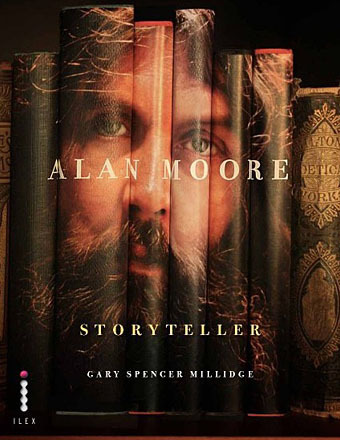
Cover concept by Chip Kidd.
I noted the imminent arrival of Gary Spencer Millidge's labour of love last month and the volume itself turned up this week, and what a book it is, a heavyweight hardback that's far more lavish than I anticipated. The first surprise comes when removing the dust jacket to find Alan's scowling visage embossed on the boards. Inside there's a wealth of Moore ephemera from biographical material (lots of family photos) to insights into the scripting process behind the comics. I already knew Alan made little thumbnail sketches of his comic layouts before writing his scripts, having been fortunate enough to see one of the work-in-progress books for From Hell one time when I was chez Moore. Now everyone can have that opportunity. In addition there's a thorough overview of Alan's career, from the earliest juvenilia through to recent issues of Dodgem Logic. The comics career often overshadows his other work but in a later part of the book there's considerable attention given to his collaborations with musicians, dancers and others for the Moon and Serpent performances. For my part it's a pleasure to see some of the designs I created for the Moon and Serpent CDs printed large-size and in better quality than pressing plants manage with compact discs. None of those releases sold in great quantities and all are now out-of-print so the artwork often feels lost.
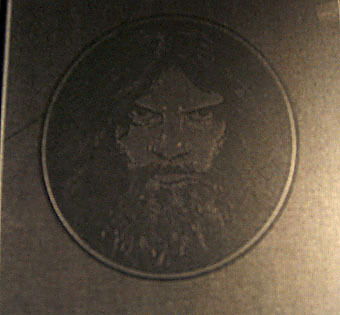
The front board.
What else? How about two sections of the book with fold-out pages? How about the first ever public appearance of Alan's huge chart mapping the progress of every character through the unfinished Big Numbers? How about an introduction by Michael Moorcock where he calls Alan "a Robert Johnson of the Age of Doubt; questioning, confronting, mourning and yearning, representing his readers in profound ways, an intellectual autodidact, one of my few true peers for whom I have limitless respect."? How about a compact disc featuring extracts from the Moon and Serpent CDs plus many other previously unreleased songs including pieces by the Emperors of Ice Cream? This is a gorgeous production designed by Simon Goggin and art directed by Julie Weir, and I haven't even begun to read it yet. Is it necessary to state that it's an essential purchase for anyone with more than a passing interest in Mr Moore and his many talented collaborators? Yours for twenty-five quid from Ilex Press. Some page samples follow.
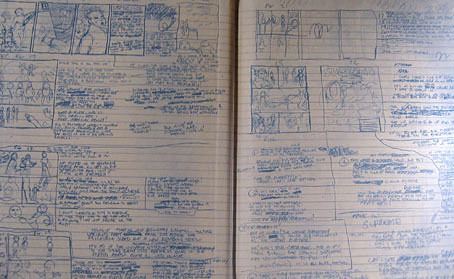
Front endpapers showing Alan's working notes and sketches.
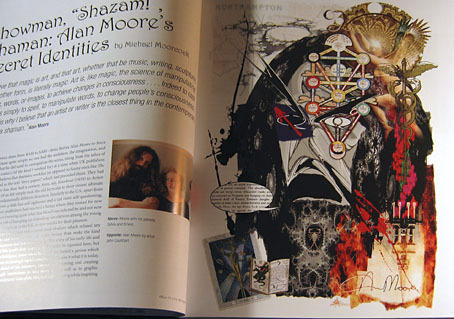
right: a collage I did in haste for one of the early issues of Arthur magazine which I'd always been dissatisfied with but which looks okay here. Alan's face, incidentally, was pieced together from bits of torn paper and strange attractor shapes.
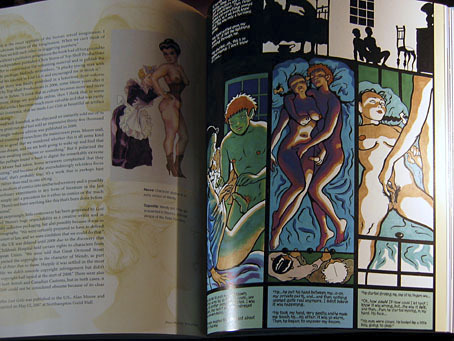
Art by Melinda Gebbie. Other books about Moore's work might evade or downplay the overt pornography of Lost Girls but not this one.
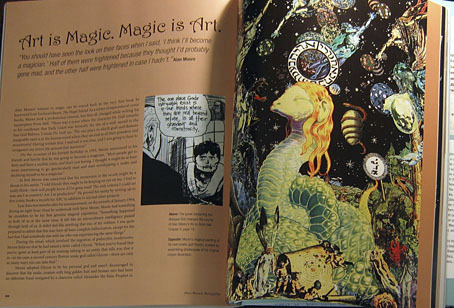
left: a From Hell panel by Eddie Campbell. right: Alan's portrait of his favourite false god, Glykon.
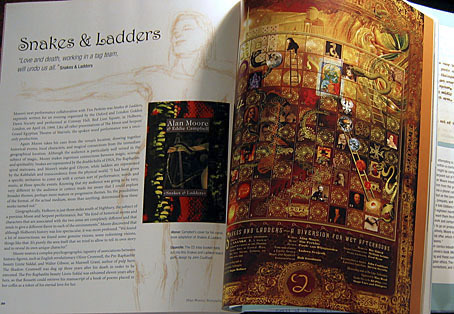
left: art by Eddie Campbell from his comics adaptation of Snakes and Ladders; right: my board game design from the Snakes and Ladders CD package.
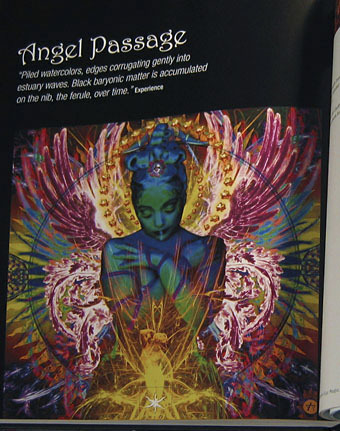
My portrait of Angel Andrea from the cover of the Angel Passage CD.
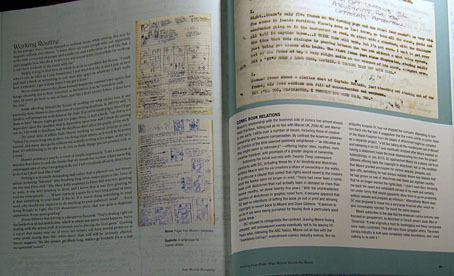
A spread showing more working methods.

And the CD.
Previously on { feuilleton }
• Alan Moore: Storyteller
• Alan Moore: Tisser l'invisible
• Dodgem Logic #4
• Watchmen
• Alan Moore interview, 1988
August 11, 2011
Darmstadt documents
More from the University of Heidelberg's treasure trove of digitised books, Die Ausstellung der Darmstädter Künstler-Kolonie (1901) is also related to Deustche Kunst und Dekoration by being a product of that journal's publisher, Alexander Koch. The book showcases the work and philosophy of the Darmstadt art and design colony, many of whose artworks and architecture designs were featured in DK&D. Since having gone through the back issues of Koch's journal I've become increasingly fascinated by the Darmstadt group and their contemporaries in the Wiener Werkstätte so finding a handful of new documents is very welcome, even if much of the work is now familiar. The continual use of the square at this period of German and Austrian design is particularly notable (Ver Sacrum, lest we forget, was a square-format magazine) and square motifs have been feeding into my own work in various ways recently, some of which will be revealed here soon.
Also in the Heidelberg archive are some related publications, Ein Dokument deutscher Kunst: die Ausstellung der Künstler-Kolonie in Darmstadt (1901) by Peter Behrens, and Die Ausstellung der Künstler-Kolonie Darmstadt (1902) by Joseph Maria Olbrich, several pages of German text but it does include a plan of the colony grounds.
Previously on { feuilleton }
• Ver Sacrum, 1898
August 10, 2011
Deutsche Kunst und Dekoration #3

A slight return to Deutsche Kunst und Dekoration, the German periodical of art and decoration. Volume 3, which covers the period from October 1898 to March 1899, was missing from the copies stored at the Internet Archive but has recently been added to the burgeoning collection of books and journals being digitised at the University of Heidelberg. What might have been a frustrating omission turns out to be less interesting than some of the editions which followed but it still features plenty of examples of the German Art Nouveau style.



Eritis Similis Deo (They were like God) (1896) by Félicien Rops.
Previously on { feuilleton }
• Deutsche Kunst und Dekoration #25
• Deutsche Kunst und Dekoration #24
• Deutsche Kunst und Dekoration #23
• Deutsche Kunst und Dekoration #22
• Deutsche Kunst und Dekoration #21
• Deutsche Kunst und Dekoration #20
• Deutsche Kunst und Dekoration #19
• Deutsche Kunst und Dekoration #18
• Deutsche Kunst und Dekoration #16
• Deutsche Kunst und Dekoration #15
• Deutsche Kunst und Dekoration #12
• Deutsche Kunst und Dekoration #11
• Deutsche Kunst und Dekoration #10: Turin and Vienna
• Deutsche Kunst und Dekoration #10: Heinrich Vogeler
• Deutsche Kunst und Dekoration #9
• Deutsche Kunst und Dekoration #8
• Deutsche Kunst und Dekoration #7
• Deutsche Kunst und Dekoration #6
• Deutsche Kunst und Dekoration #5
• Deutsche Kunst und Dekoration #4
• Deutsche Kunst und Dekoration #2
• Deutsche Kunst und Dekoration #1
• Deutsche Kunst und Dekoration
• Jugend Magazine revisited
August 9, 2011
Bestiaire Perdu
Signe de poussière (1980).
Selections from an ink-and-watercolour series by Jean-Pierre Velly, Bestiaire Perdu, or Lost Bestiary, created from 1978 to 1980.
Dans mon corps carapacé (1980).
Previously on { feuilleton }
• Detmold's insects
• Entomologia
August 8, 2011
The art of Ludwig von Hofmann, 1861–1945

Ludwig von Hofmann was a German artist whose work has already appeared via the above example from Deutsche Kunst und Dekoration. Many of Hofmann's drawings and paintings appeared in that magazine's rival publication, Pan magazine, for which the artist also provided a cover design for the collected editions, and vignettes for the interiors.

Hofmann is also of note for those of us who search art history for potentially gay art or artists. A handful of his works turn up continually on forums where homoerotic artwork is posted even though I've yet to see any evidence that his desires ran in this direction. It's true that many of Hofmann's pictures focus exclusively on the naked male form, but it's equally true that he painted and drew a large number of naked women. Males and females often appear together in Adam and Eve pictures, a theme which was so common in German art at this time it's easy to assume that most artists were using the subject as the merest excuse to represent the unclothed figure.

Ganymede poster design from Pan (1895).
Biographical details state that Hofmann married his cousin in 1899 although he still may have been bisexual, of course. If I was making a case for a Uranian inclination in his art I'd point to his poster design on the Ganymede theme (a favourite among gay artists with its story of Zeus falling for a beautiful boy), his many drawings of bathing boys and naked riders on horseback (the latter seems an obsession), Thomas Mann's admiration for his work, and at least one sketch of a boy from Capri, an island with a long history as a favourite holiday resort for the rich and famous homosexuals of Europe. Whatever the truth, many of Hofmann's pictures remain homoerotic, intentionally or not, and a few further examples are posted here. I should note that two of the pictures have been cropped to focus on the male figures, and that many of them lack verifiable dates.

Naked Youths and Boatmen.

Idyll (detail).

Adam and Eve in Paradisiacal Landscape (detail).

Riders at the Sea.

Study for Two Riders.


Riders at the Sea.
Elsewhere on { feuilleton }
• The gay artists archive
Previously on { feuilleton }
• Deutsche Kunst und Dekoration #24
August 7, 2011
Chris Parks
Chris Parks created effects sequences for The Fountain and The Tree of Life. His showreel can be viewed here.
Previously on { feuilleton }
• Len Lye
• Matrix III by John Whitney
• Symphonie Diagonale by Viking Eggeling
• Mary Ellen Bute: Films 1934–1957
• Norman McLaren
• John Whitney's Catalog
• Arabesque by John Whitney
• Moonlight in Glory
• Jordan Belson on DVD
• Ten films by Oskar Fischinger
• Lapis by James Whitney
• Expanded Cinema by Gene Youngblood
August 6, 2011
Weekend links
Faustine (1928) by Harry Clarke.
• This week's Harry Clarke fix: 50 Watts reposts the Faust illustrations while Golden Age Comic Book Stories has the illustrated Swinburne.
• What Goes Steam in the Night is an evening with contributors to The Steampunk Bible hosted in London by The Last Tuesday Society on September 6th:
Co-author S. J. Chambers invites you to the official U.K. celebration of her book The Steampunk Bible (Abrams Image). Part lecture, part signing, and part entertainment, S. J. will be accompanied by contributors Jema Hewitt (author of Steampunk Emporium ) and Sydney Padua (Lovelace & Babbage) for a discussion of the movement, a special performance by Victorian monster hunter, Major Jack Union, and inevitable hi-jinks and shenanigans to later be announced.
• RIP Conrad Schnitzler, an incredibly prolific electronic musician, and founder member of Tangerine Dream and Kluster/Cluster.
• Golden Pavilion Records reissues fully-licensed late 60′s and 70′s psychedelic, progressive, acid-folk & art-rock music.
• Dressing the Air is "an exclusive consulting and online resource for the creative industries".
• Luke Haines explains how to cook rabbit stew whilst listening to Hawkwind.
• Wood pyrography by Ernst Haeckel from his home, the Villa Medusa.
Satia Te Sanguine (1928) by Harry Clarke.
The truth is, the best novels will always defy category. Is Great Expectations a mystery or The Brothers Karamazov a whodunnit or The Scarlet Letter science fiction? Does Kafka's Metamorphosis belong to the genre of fantasy? In reality men don't turn into giant insects. And it's funny. Does that mean it's a comic novel? […] At a time when reading is in trouble, those readers left should define themselves less rigidly.
• Pace the redoubtable Jacobson, Alan Jacobs believes We Can't Teach Students to Love Reading.
• How Ken Kesey's LSD-fuelled bus trip created the psychedelic 60s.
• Salvador Dalí creates something for Playboy magazine in 1973.
• JG Ballard: Relics of a red-hot mind.
• Electric Garden (1978) by Conrad Schnitzler | Auf Dem Schwarzen Kanal (1980) by Conrad Schnitzler.
August 5, 2011
The City of the Singing Flame
Wonder Stories, July 1931. Illustration by Frank R. Paul.
Looking over Bruce Pennington's artwork this week sent me back to some of my Clark Ashton Smith paperbacks, many of which sport Pennington covers. One of my favourite Smith stories, The City of the Singing Flame, is also one of his finest pieces, and a story that Harlan Ellison has often referred to as his favourite work of imaginative fiction.
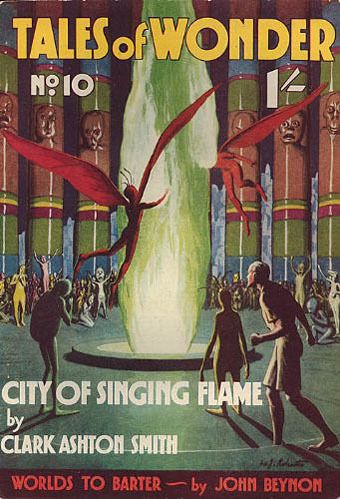
Tales of Wonder, Spring 1940. Illustration by WJ Roberts.
The story as it's known today was originally a shorter piece, The City of the Singing Flame, followed by a sequel, Beyond the Singing Flame; both stories were published in Wonder Stories magazine in July and November of 1931, then as one in Arkham House's CAS collection Out of Space and Time in 1942. The two-in-one story is now the definitive version.
Smith's tale concerns the discovery of a dimensional portal somewhere in the Sierras. Beyond this there lies a path leading through an otherworldly landscape to a city of colossal size peopled by a race of mute giants. At the heart of the city a temple stands which protects the prodigious green flame of the title, an eerie and alluring presence whose siren call draws alien creatures from adjacent worlds who prostrate themselves before the flame before immolating themselves in its fire. A narrator, Philip Hastane, give us details of diary entries from a friend who discovered the portal and who subsequently has to decide whether to resist the lure of the mysterious flame or follow the other creatures into the fire. More than this would be unfair to divulge if you've never read Smith's remarkable piece of fiction.
Wonder Stories, July 1931. Illustration by Frank R. Paul.
Re-reading the story again this week I was mostly struck by what might be regarded as a psychedelic quality to much of the description and the transcendental impetus which drives the narrative. Jorge Luis Borges in Kafka and his Precursors noted how any sufficiently powerful artist fixing in their work a previously unexamined quality gains a train of previously disparate precursors, all of whom are thereafter connected by that quality. This syndrome can apply to art movements as much as artists or writers. Just as stories prior to Kafka can be deemed Kafkaesque, so painting before Surrealism can be deemed Surreal, and art prior to the 1960s can be regarded as psychedelic. Here's Clark Ashton Smith sounding like a mescaline voyager in 1931:
Any attempt to describe the experience would be foredoomed to futility, since it seemed that a whole range of new senses had been opened up in me, together with corresponding thought-symbols for which there are no words in human speech. I was no longer Philip Hastane, but a larger, stronger and freer entity, differing as much from my former self as the personality developed beneath the influence of hashish or kava would differ. The dominant feeling was one of immense joy and liberation, coupled with a sense of imperative haste, of the need to escape into other realms where the joy would endure eternal and unthreatened.
My visual perceptions, as we flew above the burning, lucent woods, were marked by intense, aesthetic pleasure. It was as far above the normal delight afforded by agreeable imagery as the forms and colours of this world were beyond the cognition of normal eyes. Every changing image was a source of veritable ecstasy; and the ecstasy mounted as the whole landscape began to brighten again and returned to the flashing, scintillating glory it had worn when I first beheld it.
References to drugs are scattered throughout the narrative, mostly in symbolic terms:
My homeward journey was blurred and doubtful as the wanderings of a man in opium-trance; and the music sang behind me, and told me of the rapture I had missed, of the flaming dissolution whose brief instant was better than aeons of mortal life….
But later we have a detail which implies some personal experience:
The exhaustion that still beset me was too profound to permit of thought or feeling; it was like the first reaction that follows the awakening from a drug-debauch.
I've never read much of Smith's life so I've no idea how much of his fiction, if any, was fuelled by actual drug experiences. But he did write a long poem in 1920, The Hashish Eater, or The Apocalypse of Evil, which brought him to the attention of HP Lovecraft, and many other stories feature similar references. Most of those references, however, tend to be part of the exotic detail with which Smith encrusted his fiction. In City of the Singing Flame we have a richer sense of the expanded consciousness which occurs at the height of hallucinogenic experience. Beyond the druggy atmosphere there's also some fantastic invention: the Cyclopean city and its strange visitors (none of whom are ever a threat to the human observers), the otherwordly landscapes and transhuman sense impressions, and the unseen creatures intent on destroying the home of the Singing Flame who attack the city with a walking metropolis of their own.
The City of the Singing Flame, 1981. Cover by Rowena Morrill.
It's a shame Bruce Pennington didn't provide a cover for the Panther paperback which reprinted this story, many of the attempts at illustration fail to do Smith's vast and bedizened imagination any justice at all. Frank Paul's conception of the flame is far too small and he also gives the scene a science fictional gloss which doesn't match any of Smith's descriptions. Rowena Morrill, on the other hand, does a superb job depicting the moment when the narrator, Hastane (here looking hunkily attractive), encounters a pair of benevolent moth-like aliens who carry him to the city.
The City of the Singing Flame has been reprinted many times since 1942 so it's easy to find. The leading Clark Ashton Smith website is still Eldritch Dark, and they have a copy of the entire story here should you wish to discover the secret of the green fire. It's a trip, in more ways than one.
Previously on { feuilleton }
• The Vengeance of Nitocris
• Haschisch Hallucinations by HE Gowers
• Odes and Sonnets by Clark Ashton Smith
• The King in Yellow
• Clark Ashton Smith book covers
August 4, 2011
Wilhelm Volz's Salomé
Wilhelm Volz (1855–1901) was a German artist whose work I might not have paid any attention to at all had this lithograph not been featured in that cult volume Dreamers of Decadence. As a composition it's a lot more interesting than Volz's paintings, the circle for a halo being an unusual detail. There's also more of an atmosphere of horror in this representation than one usually finds with the Salomé theme. The temptress doesn't seem very enamored of her trophy, and John the Baptist's head for once bears a suitable expression of horror. Volz's print was published in Pan magazine in 1896, the entire edition of which may be viewed here.
Previously on { feuilleton }
• Valenti Angelo's Salomé
• Dalí's Salomé
• Wild Salomés
• The Salomé paintings of Caroline Smith
• Mossa's Salomés
• The art of Marcus Behmer, 1879–1958
• Several Salomés
• Julius Klinger's Salomé
• John Vassos's Salomé
• René Bull's Salomé
• Steven Berkoff's Salomé
• Manuel Orazi's Salomé
• Salome's Last Dance
• Salomé posters
• Salomé scored
• Beardsley's Salomé
• Peter Reed and Salomé After Dark
• Alla Nazimova's Salomé
John Coulthart's Blog
- John Coulthart's profile
- 31 followers








